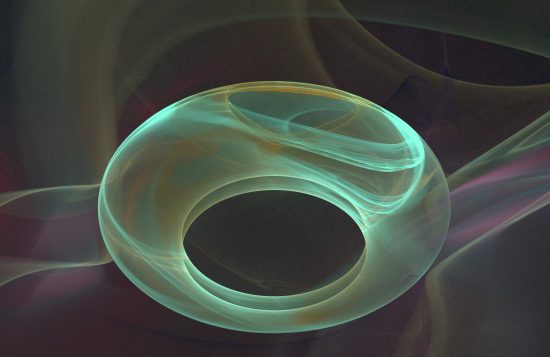
May 18, 2020
Three space coordinates and one time coordinate in a five dimensional manifold?
According to Einstein, and most astrophysicists who follow after him, time and space are dynamic regions under constant change. Rather than convenient conventions, or useful tools, that help to identify the locations of objects—a.k.a. their coordinates—scientists today seem to view the combined concepts as a kind of “object”, or a four-dimensional matrix.
In this conventional viewpoint, if the Universe is considered as a whole, then all events are there from start to finish, since time came into existence at the same time as matter. Each object traces a spatial existence that stretches from past to future, indicating its position in space at every instant of time. This is a philosophy introduced to physics by Hermann Minkowski, Einstein’s professor at the Zürich Polytechnic.
As written elsewhere, Minkowski thought that all objects are really “four-dimensional” in a framework that is now called “Minkowski spacetime”:
“A point of space at a point of time, that is, a system of values, x, y, z, t, I will call a world-point. The multiplicity of all thinkable x, y, z, t systems of values we will christen the world…Let the variations dx, dy, dz of the space co-ordinates of this substantial point correspond to a time element dt. Then we obtain, as an image, so to speak, of the everlasting career of the substantial point, a curve in the world, a world-line…The whole universe is seen to resolve itself into similar world-lines, and I would fain anticipate myself by saying that in my opinion physical laws might find their most perfect expression as reciprocal relation, between these world-lines.” [Hermann Minkowski, “Space and Time” in Hendrik A. Lorentz, Albert Einstein, Hermann Minkowski, and Hermann Weyl, The Principle of Relativity: A Collection of Original Memoirs on the Special and General Theory of Relativity].
All substantive particles are said to reside within distortions of spacetime called “warps”. The common description of this condition relies on visualizing a sheet of stretched rubber with a bowling ball resting on the surface. The bowling ball forms a dimple in the rubber sheet, supposedly illustrating how the Sun (or some other massive object) creates a “bubble” of distortion in three dimensions.
Assume some entity with tremendous inertial mass collapses at the end of its life into a fraction of its volume. One moment it is there and the next moment it is not there. What happens to its bubble in spacetime? This is where gravitational waves come into play. As the star collapses, its bubble also collapses. If the bottom of a body of water suddenly drops, it causes the water’s surface to ripple, forming waves that spread out from the center. That is the principle of gravity waves: inertial mass collapse (not matter, mass) in a four dimensional bubble of spacetime. The entire continuum vibrates, as the idea suggests.
Therefore, in Minkowski spacetime, gravity is not a force, it is a curvature through a five-dimensional representation. Using the Sun and rubber sheet analogy, any object approaching the Sun in its bubble follows a curved path around it. The closer to the Sun, the more dramatic its influence on the object. No forces are involved, only “spacetime” warped by matter. In the four-dimensional Universe, scientists think that the same principle applies: objects follow curved paths because of spacetime distortions.
According to a recent press release, it is those spacetime distortions that enable astronomers to define a mysterious signal that is more powerful than anything they have seen. Isobel Romero-Shaw from Monash University wrote:
“‘We propose that [cosmic event] GW190425 formed through a process called ‘unstable case BB mass transfer’… It starts with a neutron star which has a stellar partner: a helium (He) star with a carbon-oxygen (CO) core. If the helium part of the star expands far enough to engulf the neutron star, this helium cloud ends up pushing the binary closer together before it dissipates. The carbon-oxygen core of the star then explodes in a supernova and collapses to a neutron star…Our study points out that the process of unstable case BB mass transfer could be how the massive star system formed.”
Relying on the spacetime view of Minkowski continues to cause many problems, but after decades of debate and analysis those problems remain unresolved.
Electric star theory suggests that no concentrated gravity from hypothetical objects is necessary. Classical electromagnetism does not depend on supernatural physics. Previous Picture of the Day articles address the neutron star theory. Deficiencies in gravity-dominated cosmology created neutron stars, because gravity is granted endless powers. It must be stressed, though, that no neutron star has ever been observed, rather it is intense electromagnetic fields that are seen.
Electromagnetic fields are induced by electric currents, so there must be a flow of electric charge generating the intense fields. It is indisputable that feeder currents must be part of a circuit, since persistent electric charge must travel through a completed electric circuit. Dense matter and extreme rotation are unnecessary, because electricity traveling through circuits provides an explanation consistent with electromagnetic theory.
Neutron star oscillations are caused by resonant effects in those electric circuits. It is the sudden release of stored electrical energy in a “double layer” that is responsible for their energetic emissions. The outbursts begin with a sudden peak of energy, and then gradually decline, like a stroke of lightning. Depending on how much electricity is flowing through the circuit, a star’s electromagnetic field will be greater where there is more current. It seems more likely that such “cosmic events” are immense concentrations of electricity focused by some kind of dense plasma focus effect.
Stephen Smith
The Thunderbolts Picture of the Day is generously supported by the Mainwaring Archive Foundation.












